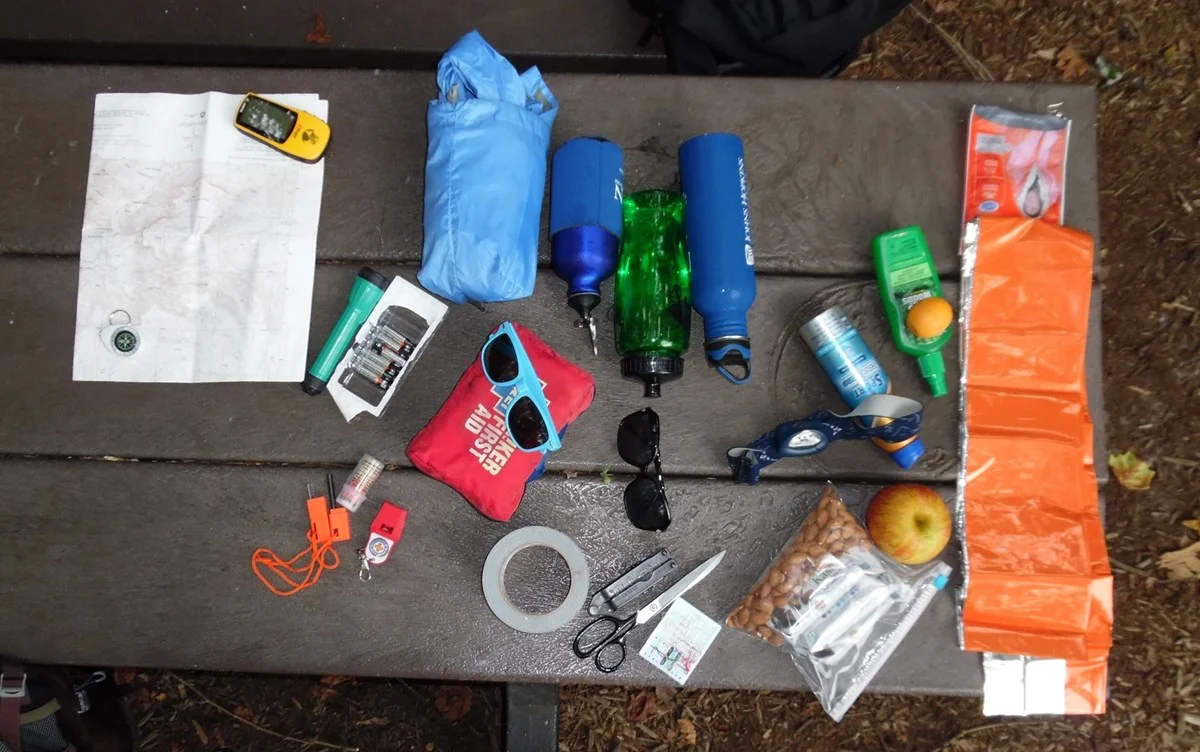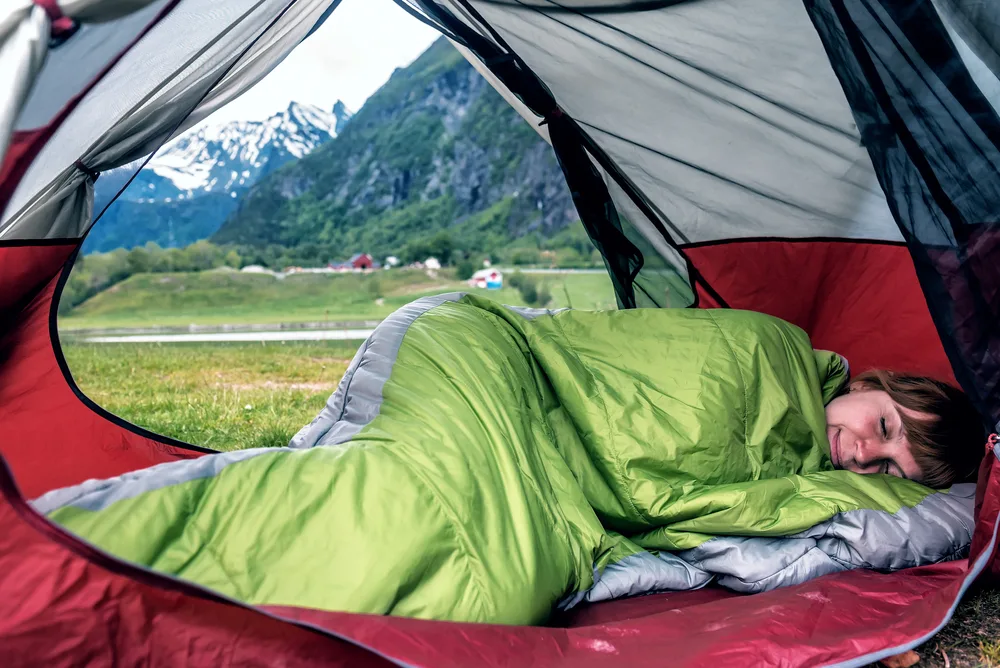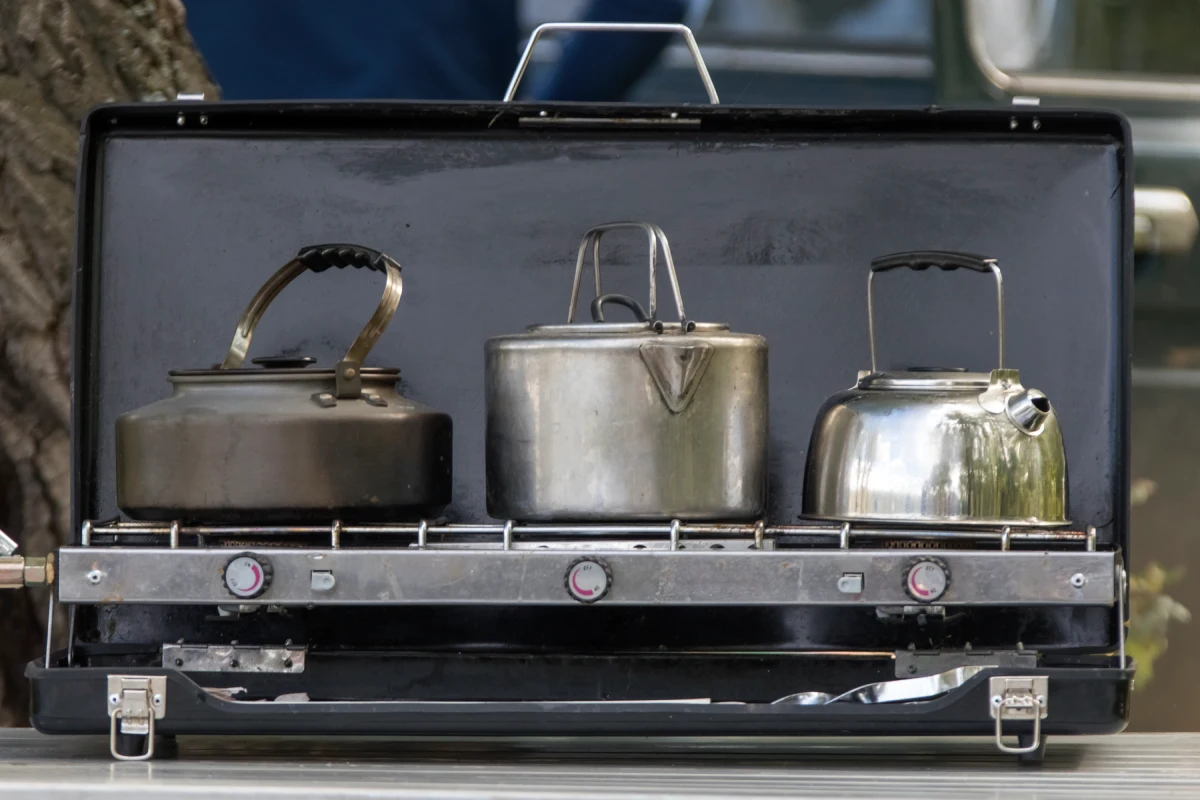How to choose a camping stove will depend on how you spend your time outside. Are you spending time at the group campsite cooking a meal for your family and friends? Or, are you a solo camper or backpacker attempting to scale Mount Everest? The latter scenario seems unlikely, but we all want a versatile product. Ultimately, most of the available camp cookers sit between these two uses.
I know buying a new stove can be overwhelming with the amount of models and options. With this in mind, I wanted to assist you in getting proper information.
To help you with your research, below is my definitive 2024 guide on “how to choose a camping stove.” In this article, learn how to choose the right stove for you. Discover what’s right for your specific use, fuel types, BTUs, the best size, and how to be safe.
If you are looking for specific information, there is a navigable table of contents. Or read the entire guide, it’s up to you.
Group Camping Stoves Versus Solo Backpacking Stoves:
The biggest difference in outdoor stoves is their specific purposes. The first thing to consider is your activity. Are you planning to group camp at a designated campsite? Or, is your plan to trek out in the wilderness by yourself? Below is an explanation of each type of activity to help you select the right stove for you.
What is group camping?
Group camping consists of packing up your vehicle and traveling to a campsite. The hard work is unloading and pitching a tent after that you get to relax. In general, gear for group camping is sturdy, built for comfort and weighs a lot.
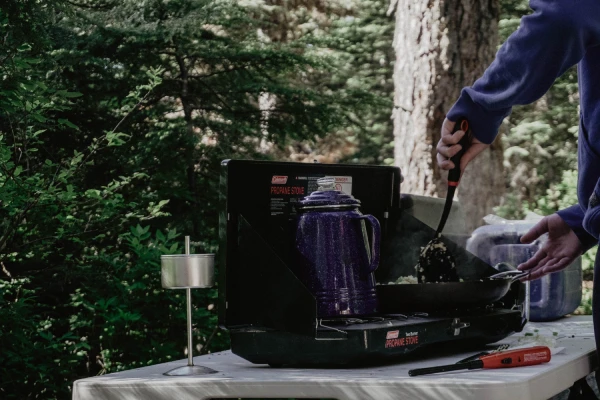
Stoves for group camping are no different. These stoves need to feed two or more people and sit in place the entire time you are camping. They are 2+ burner workhorses that burn liquefied petroleum gases. This type of stove excels for boiling water or whipping up a gourmet breakfast.
Solo Camping or Backpacking: Explained
This is exactly as it sounds, you trek into the wilderness without anyone else. For this activity, users have special backpacks filled with specific gear needed to survive. This type of gear is smaller, lighter, and very specific for each use.
Purpose-built backpacking stoves have one or two burners. These stoves are very light, compact, and designed to be fast at boiling water for a single pot. They function in most climates, but I don’t like using them for group cooking. Due to the waste of fuel and inefficiency in performing group cooking.
Stove Types: Tabletop or Freestanding
There are two different types of outdoor stoves for group camping. These are the tabletop and the freestanding. Below is a simple explanation of each type.
Why choose a tabletop camp stove?
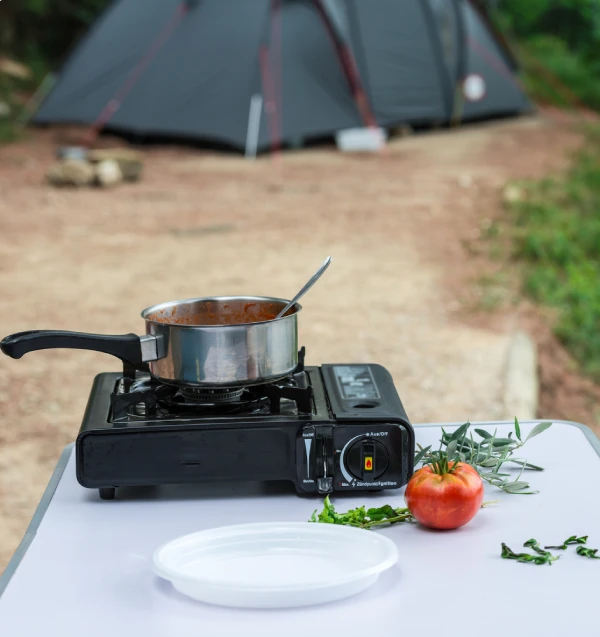
Choose a tabletop model if you need a compact and portable group camping cook station. It’s best suited for solo car camping or smaller groups. Some drawbacks are they have a limit in power and the smaller size or number of burners. Another consideration is your location; it has to be a flat and steady surface available. If there isn’t, you may need to buy a dedicated stove table to match.
What is a freestanding outdoor stove:
These stoves are bigger, heavier, and harder to transport. Being larger may sound like a deterrent but the cooking versatility of this stove more than makes up for it. As the name suggests, these stoves do not need a table, since they have built-in legs. If you don’t have to carry a stove far, are cooking up big meals and have plenty of space, it’s the stove for you.
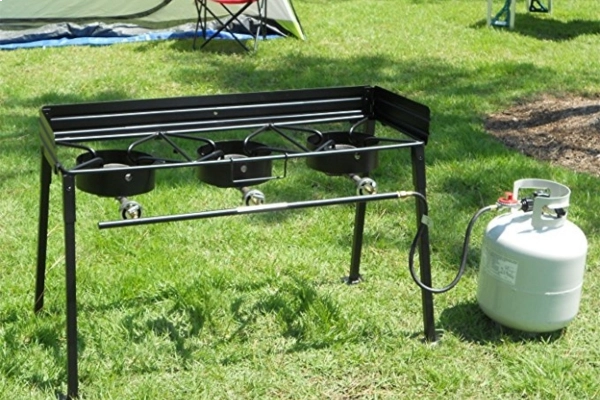
What Size Camp Stove Is Best?
The first question you have to answer is how many people you want to feed. In general, you will first decide between either a tabletop or freestanding model. When it comes to group or car camping, most campers prefer the table-top type. Next, after picking a type of stove you will pick the number of burners.
Number of burners
The common number of burners for these stoves are single, two burners and multi-burners. To select the right number of burners imagine how many burners you need to cook on at the same time.
Single burner – 3 or fewer people
Single burners are great for lightweight one-pot meals or boiling water fast. Coveted by the backpacker and solo campers due to taking up the least amount of space. It is inexpensive to buy and simple to operate. If people don’t mind simple meals this type is plenty for groups of up to 3 people. Expect to use small fuel canisters with this size of stove.
Two burners – 7 or fewer people **
Generally, this is the most common number of burners and for good reason. Two burner camp stoves offer great cooking versatility in a compact form. If you want to further save weight and space look for foldable camp stoves. These stoves pack into a car while offering a decent amount of BTUs for a small group. You can use one burner for a pot where you are boiling water and the other for a pan for heating something else. Like the single burner stove, this size also uses gas canisters.
** With 4 plus people, it’s best to add an extra single burner stove to offer better cooking efficiency.
Multi-burner – 8 or more people
For the chef cooking for a large group, there are stoves with multi-burner designs. These are large, heavy stoves that you will see in three-burners or more. If three-burners aren’t adequate, certain styles of stoves could be daisy-chained together. In this instance, you need a large campground for safe cooking and sleeping. A multi-burner may use a large canister or run off of a refillable cylinder.
Packed Stove Weight:
Packed weight is a crucial consideration for campers. This factor can make or break a camping trip. Imagine carrying it for a distance, it has to be comfortable to hold. If you are hiking or have limited space, choose a small portable two-burner stove. Many people can navigate decent terrain with this style and weight of stove.
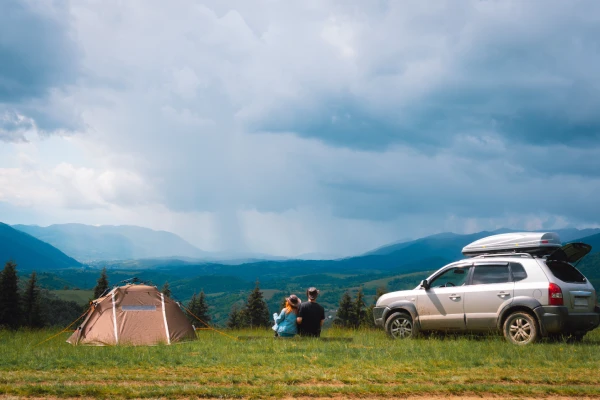
This will change depending on how many bellies you have to feed though. If you have a large group or are out with an RV/car, it’s best to forgo pack weight. In this case, go with a multi-burner freestanding stove.
Which Stove Fuel Is Best?
Like the type and size of the stove, the fuel type you choose is dependent on your activity. For car campers, liquefied petroleum gases are the most popular fuel choice.
What’s liquefied petroleum gas (LPG)?
Liquefied Petroleum Gas (LPG) is a pressurized liquid stored in a canister or a cylinder. Most cylinders are refillable, whereas a canister is often single-use. This is the most common fuel for group camp stoves. The three types of liquefied petroleum gases (LPG) are propane, isobutane, and n-butane.
Most LPGs are easy to find and affordable to buy. Likewise, they have the best heat-to-weight output. Keep in mind, that propane and isobutane burn in frigid temperatures, whereas butane doesn’t.
How does LPG fuel work?
First, the manufacturer compresses it into liquid at low pressures. Next, they pour the liquid LPG into heavy gauge steel gas canisters, cylinders or tanks. These portable tanks store the liquid until it is ready for use.
- Imagine a storage tank is see-through, the LPG would be liquid at the bottom and vapor near the top.
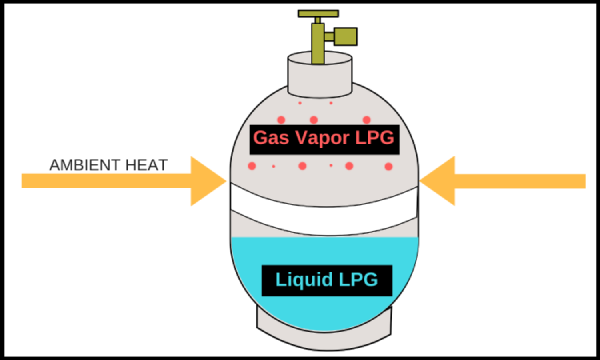
For outdoor-style stoves to use LPG fuels the liquid in the bottom needs to “boil” into a vapor. The boiling process is like water boiling. Imagine the steam in a water boil, it’s the same for the gas vapor in an LPG boil. The two major factors that lead to boiling are pressure and temperature.
Temperature: To aid a “boil”, the liquid LPG draws heat from the steel walls of the tank. These walls get heat from the ambient outside air.
Pressure: As you open the gas valve and turn on your camp stove, you lower the pressure inside the tank. Lowering the pressure boils the liquid LPG into a vapor.
The LPG vapor gas returns into a liquid by closing the gas valve. This will increase the tank’s internal pressure without reducing the temperature.
2 most important factors for choosing an LPG type:
Boiling Point: Temperature that an LPG’s vapor pressure equals its liquid pressure. At this point, the liquid boils into a gas. Fuels will struggle to vaporize at temperatures below their “boiling point.”
Vapor Pressure: LPG’s ability to remain pressurized at different temperatures. The LPG with low vapor pressure won’t work in cold ambient temperatures; for example butane.
As a result, the lower the boiling point of each LPG, the greater the vapor pressure. In simple terms, the better the performance you will get in colder temperatures.
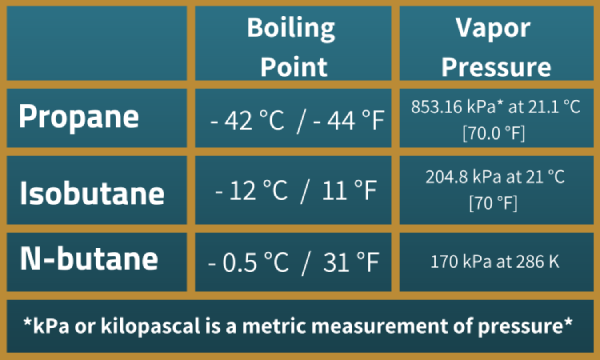
Varieties of LPG gases for camp cooking:
Propane:
Propane is by far the best-performing and most common type of camping stove fuel. There are single-use propane canisters at gas stations or grocers across the country. On multi-day trips or with large groups there are large reusable tanks as well. Make sure to read the manufacturer’s instructions and use an approved adapter. Large-size 20-pound (9.07 kg) reusable tanks will save you money on fuel costs over time.
For convenience, it’s a good idea to buy an adapter hose for your stove. This adapter enables you to switch from canisters to tanks depending on how long you are camping.
There are two considerations to look for in an adapter hose. One is length; a good hose length is at least 5 feet (1.52 meters). Ease of use is the second consideration because different brands use different hoses. Each brand has different knob sizes for screwing on and off, while others with big plastic grips. The latter is the best because the process is quick and painless.
Isobutane:
This is another common liquid fuel, especially with the backpacking crowd. It does offer an acceptable vapor pressure in cold weather. Backpackers love how ultralight weight it is; the canisters weigh less than propane. Weight savings are critical for backpackers, but for group campers don’t worry about it. Isobutane is an expensive gas to make and expensive gas to buy. Therefore, backpacking users buy small lightweight quantities. This isn’t a recommended fuel for group stoves unless you like spending money.
N-Butane:
Known as the bastard fuel in popular culture, due to it burning dirty. N-butane does have many pros such as; it’s cheap to buy, igniting in an instant and is very light. In the event you are winter camping don’t use this fuel type. It has the highest boiling point and the lowest vapor pressure. This LPG is more suited for backcountry hikers or using it for small lighters and torches.
Liquid Fuel For Outdoor Stoves
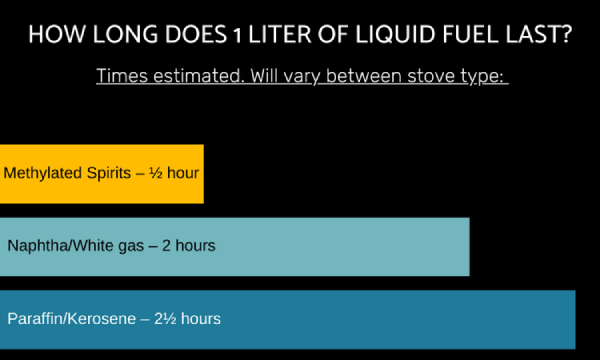
Unlike the LPG fuels, this type of fuel burns as a liquid. With a liquid burn, pressure and temperature don’t factor in its performance. So you can find it all over the world, ignites in an instant and burns in freezing temperatures or at high altitudes. There are four types used in camp cooking, including white gas, alcohol, paraffin and multi-fuel. See below for an explanation of each type.
Naphtha/white gas
Naphtha is a flammable liquid petroleum product. It’s made from natural gas or distilled from oil, coal tar or peat. Naphtha puts out a high level of heat and has a lack of additives. For these reasons, it’s less likely to clog stove fuel lines. Naphtha is the best liquid fuel for frigid backpacking treks up in high altitudes. There are many varieties of Naphtha; the most common to campers is white gas.
Invented in the 1950s for fueling cars, white gas will burn cleaner than other naphtha varieties. Plus it’s the easiest for starting your stove. The big advantage compared to other liquid fuels is that it doesn’t give off black smoke or toxic fumes. A disadvantage is that if exposed to air it will degrade fast. As it degrades, it clogs the fuel lines in camp stoves. You can store an unopened canister of white gas for five to seven years.
Alcohol – methylated spirits (Meths)
Meths is a form of ethanol (ethyl alcohol), it isn’t alcohol for consumption. It’s a combo of methanol (methyl alcohol), pyridine, and a methyl violet dye. The last ingredient is what gives its purple color. This fuel burns at half the heat of other liquid fuels. Since heat is integral for cooking this fuel is inefficient for campers. A common user is high-altitude mountaineers. As a camper, this type isn’t a reliable fuel and falls into a DIY fuel category.
Paraffin or kerosene
Paraffin known as kerosene is a lamp oil made of a distillation of crude oil. This type burns very hot, in fact as it burns kerosene is hotter than any other fuel. An advantage of this type how easy it is to control.
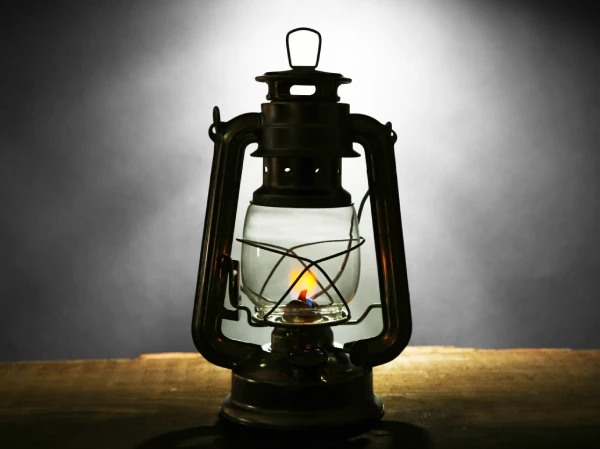
The disadvantage is that it is smelly and produces ashy soot in the fuel lines leading to clogs. Plus it doesn’t evaporate if spilled, so kerosene is a terrible choice for the planet.
Multi-fuel
This is a combination of two fuel types and the stoves that use a multi-fuel are complex products. They are small, lightweight cookers designed for backcountry campers or mountain climbers. For group camping or easy solo camping, using a single fuel-type stove is fine.
Eco-Conscious Stove Fuel Alternatives:
Using wood for camping stove fuel
For earth-conscious campers, there’s always the option of wood-fueled stoves. Homemade wood stoves are as simple as setting up a windscreen and burning the wood inside it. The other option is to buy a special wood stove that burns biomass (sticks, dried grass).
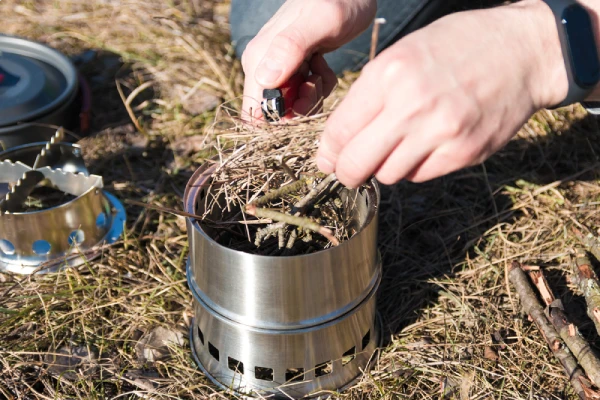
The advantage of wood is it will reduce your fuel costs to zero, as long as you can find wood. As well, it can provide endless hot water boils and do double duty as a heater on cold nights.
Problems arise if wood isn’t available and wildfire bans are happening. If you do choose wood fuel, expect to find soot on the bottom of your cookware and smoke smell on your gear.
Charcoal
Charcoal is a lightweight black carbon residue produced from animal and plant materials. For campers, there are several charcoal grills on the market for example a hibachi. While the actual stoves are cheap, you have to pay more for the charcoal fuel. It will burn at higher temperatures, and give off very little smoke compared to wood. However, trying to get this fuel to an adequate temperature for cooking purposes can take a long time. The smoke produced by charcoal is dirty, but the distinctive tasting food makes up for this.
Solar
If you want to ditch non-reusable fuel and cook using the sun, choose solar camping stoves. Bear in mind though, that solar energy varies by location and time of the day. You cannot cook in the dark with solar!
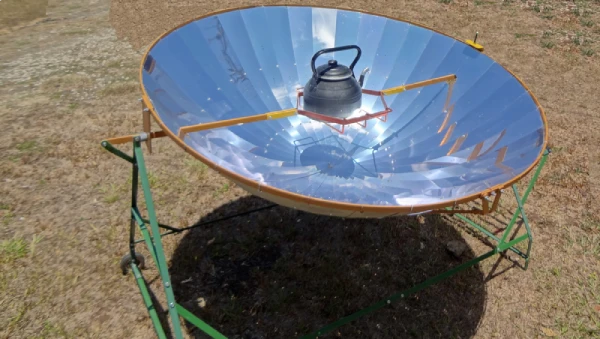
But for those of you who camp in desert locations, the sun might be the best fuel available.
Stove Power: BTU’s Importance For Outdoor Cooking
The acronym BTU stands for British Thermal Unit and is a measurement of heat. It is the amount of heat needed to raise the temperature of 1 pound (0.45 kg) of liquid water by 1 °F (-17.22 °C).
For a Celsius measurement, the term is a Calorie. It is the same measurement but with 1 gram of water to 1 degree Celsius.
If you’re searching for heating requirements in outdoor stoves, look for a measurement such as 10,000 BTU per Hour.
Why use BTUs for camp cooking?
Did you know that the act of boiling water is what “cooks” food suitable for basic nourishment? This is true for heating water inside a pot or boiling off the water molecules found inside your food. Since food plays an important role, we need to pay special attention to how we cook outside.
In a perfect situation, the higher the BTU or Calorie, the faster the water will boil. Knowing this should make it easy to choose a camp stove; you pick the highest BTU rating, right? Nope, it is important to realize that we can’t control the outdoor weather. For example, we can’t control how cold or how windy the campsite is.
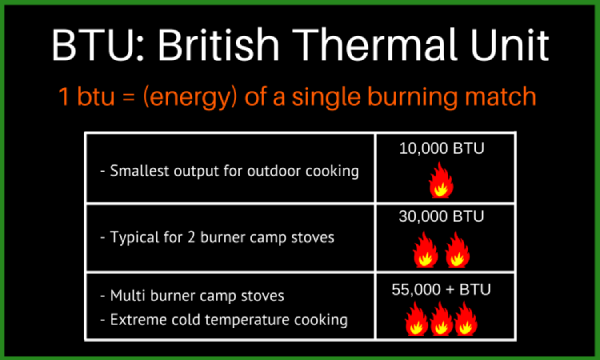
This is a basic example of a requirement for BTUs and camp stoves. Say you were trying to boil one large pot of water for a pasta dinner for your family of four. This would be the smallest output for basic group camp cooking needs. To achieve this you would look for a stove with at least 10,000 BTU per hour. But, if you are trying to boil that pasta and cook something else on a separate burner. You should look for a stove with at least 30,000 or more BTU.
Note: Be aware that some companies list the BTU of an entire unit. Whereas other companies will list the BTU of each burner. Imagine two nearly identical stoves next to each other. The first is a three-burner, but in total a 25,000 BTU unit. The second version is a two-burner but may have two 12,500 BTU burners. This two-burner unit is more powerful than the three-burner!
Stove power considerations based on camp stove type:
Tabletop Single Burner: A single burner has an output of around 7,000 BTU/hr. While the power of this stove isn’t awe-inspiring, it does a fine job of cooking food. In addition, if time isn’t an issue, it will boil a liter of water in about 5 minutes.
Freestanding Single Burner: Power for this type of stove varies a great deal. Basic models put out about 10,000 BTU/hr, while higher-end models can have about 34,000 BTU/hr. Remember, the model you choose depends on your cooking needs.
Tabletop Double Burner: The power range for this type starts from a simple version at 10,000 BTU/hr. Complex expensive models have power outputs of around 20,000 BTU/hr. The higher-end version has powerful burners, boils water fast, and has good simmer control.
Freestanding Multi-Burner: Have power outputs of around 30,000 BTU/hr. These are heavy and complex designs meant for the ultimate “camp chef.”
Choose An Ignition Type Based On The Fuel Type Used.
How simple is it to ignite each camp stove by fuel type? Some camp stoves use a Piezo (instant) ignition, while other types need patience and skill. Piezo igniters use a pressurized electric charge to ignite the fuel with the press of a button. They are easy to use and keep your hand out from the burners. The downfall of these igniters is the added cost and the notorious poor life expectancy.
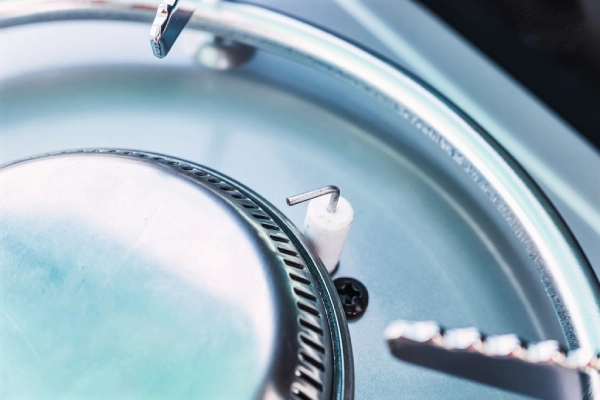
Below is an explanation of the quirks of each fuel type based on their ignition type.
LPG igniter
Simple to use, but heavy, many have some simmering control. Most modern models use Piezo Ignition. Ignition issues occur due to a broken Piezo igniter, but there is an easy workaround. You can use a pre-lit match to light this type of fuel. Be careful doing this though.
Liquid (naphtha)
Fussier to operate because they need to have priming to begin ignition. First, you pump the fuel bottle to pressurize the contents and prime the burning area with a few drops of fuel. Next, you can attempt ignition of the stove. A bonus is that this fuel allows for some simmer control.
For quirks, stoves using this fuel need periodic cleaning of any hoses and regular cleaning of the seals and O-rings. For campers that enjoy quiet in the wildness, this fuel can run a bit noisy.
Liquid (alcohol) ignition
Some need special priming to start, others you can fill and light with a match. Every time you cook, you have to measure out precise amounts of fuel, which is annoying to some campers.
An advantage to this fuel is that it doesn’t need to be under pressure to burn. Which makes it safe and quiet for cooking. A disadvantage is how clear the flame burns in an alcohol stove. Making confirmation of operation difficult. This fuel is best for solo camping or backpackers.
Liquid (paraffin/kerosene)
With dirty and complicated operation this is another fuel that needs special priming before ignition. While fun for DIY campers who enjoy tinkering with their stove equipment, this fuel isn’t for the faint of heart. It increases repair and maintenance in the field. Expect smelly clothes and blackened pots with this type of fuel.
Creating Fire With Wood And Charcoal
Igniting wood or charcoal requires patience and skill. No one-button igniter to use, you have to build a fire the old way. Cooking with these fuels needs vigilance and time to control heat output. Expect soot-covered pots and all your gear to smell like burnt fuel.
Solar Heat
Solar stoves are reliant on the sun and prone to windy conditions. You don’t use an igniter, on the contrary, you place the stove in direct sunlight.
Expect this “fuel” to take a long time to cook. Beware it takes a certain level of expertise to use this fuel type. Depending on the location or situation there are times this won’t heat food to safe temperatures. It’s better for high-altitude solo campers or backpackers.
Considerations That Affect Cooking Performance At Camps.
To further narrow down which type of stove is right for you, these are some further considerations.
Boil Time
The main measurement for cooking performance is “boil time.” This is how long it takes for a quart/liter of water to boil on the highest heat and at sea level. A good performance time is about 3 to 5 minutes, which satisfies the most grumpy morning camper.
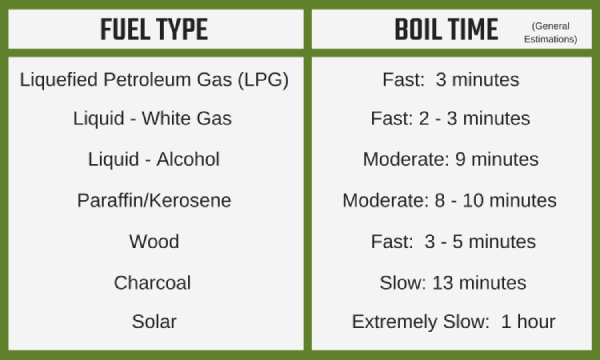
Refer to the BTU measurement I mentioned before. The higher the BTU, the higher the power. The higher the power, the faster the boil time. Bear in mind, if camping in high altitudes and cold weather expect longer cook times.
Simmer control (ease of use)
How low can the flame go? The answer is using simmer control. This is the user’s ability to regulate the strength of the flame and fuel output. Expensive tabletop and freestanding models provide precise controls and greater finesse. The opposite is true for budget options, as they tend to favor a one-flame-for-every-occasion output.
Wind protection
Wind protection plays a major role in camp stove performance due to wind being a quick killer of stove burners. A small breeze will reduce the size of the flame if simmering at low heat. Below is what to expect with each type of camp stove:
Single burner stoves: Many models forgo built-in wind protection. However, solo campers and backpackers buy add-ons or DIY-build windscreens. A separate windscreen means one more item to pay attention to while cooking though – a bit annoying.
Two + burner stoves: For tabletop or freestanding stoves most have built-in windscreens. Their lids open up and provide a full wind block from the rear. For cross winds, these stoves have side panels. Lift the side panels and snap them into the lid, to create three-sided protection.
Cold Weather Stove Considerations
Cold-weather stove operation can be challenging, especially if you are camping on snow or ice. You could try using an insulated stove platform like an aluminum-wrapped foam.
Another consideration in cold weather is the need to warm the fuel before burning it. Keep in mind, that “cold” can also be wet. To combat the cold and wet bring waterproof matches with you, no matter which stove you have. Solar stoves won’t work in cold wet climates. Unless you plan to dose the stove in fuel and burn the entire stove as your fuel.
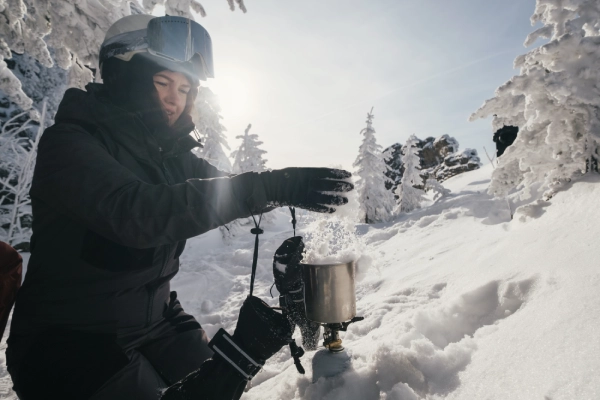
Best camping stove fuel for cold weather:
- Liquid (naphtha & paraffin) – Excellent in subfreezing temperatures.
- Wood – Will burn at low near-freezing temperatures. If camping in the snow, dry wood could be hard to find.
- Solar – The sun can cook food in cold temperatures. It is best to use solar at high altitudes. This area equals thinner air which allows for higher levels of solar radiation.
- Liquid (alcohol) – Poor below freezing and needs preheating to help get started. Placing a liquid-fueled stove on the ground is a bad decision. Due to the cold ground temperature cooling the fuel to the point it won’t light.
- LPG – May not ignite in sub-freezing temperatures and wind affects this fuel.
Camping Stove Accessories:
Camp cooking with pots and pans isn’t the only way to cook while camping. Another is upgrading, and adding a griddle to your camp stove setup.
Griddles & grilles
What’s a griddle? A griddle is a long flat surface, meant to cook eggs, pancakes, and other “flat” meals. What about a grill? Like a griddle, a grill adds a ridged surface, meant for cooking meat, veggies, and fish.
When looking to buy a griddle or grill accessory, pay attention to its size. As long the dimensions of a griddle or grill match your stove surface, the accessory should work well.
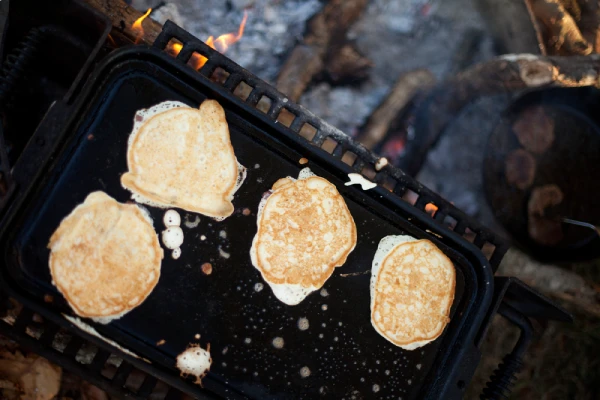
Buying Considerations For Camp Stove Accessories:
Cast Iron: This is the best material for griddles and grills. This material lasts as long as you take care of it. In addition, it cooks food well. However, make sure to find quality one, because cheap cast iron deteriorates.
Combinations: The ultimate convenience! Some companies make a griddle/grill combo. One side is flat for eggs and pancakes, while the other has ridges for meat and veggies.
Handles: This is a no-brainer right? Without handles a griddle or grill is a safety hazard if it overheats. Plus handles are helpful for cleaning. Unless the brand of your stove makes a handleless griddle/grill, buy one with handles.
Length: Some brands make griddles/grilles, which cover the entire stove surface. Using this kind will prevent you from using the other burner for a single pot. Others make single burner ones, which are more versatile. What you choose will depend on how you cook.
Adjustable Legs: What do you do if you can’t find a picnic table in a campsite that is flat or level? Don’t fuss with onsite solutions, it’s easier to buy add-on adjustable legs. Adding these legs will allow you to level out your stove no matter where you camp. Otherwise, expect to hunt around for the perfect flat place to level the stove surface.
Camping Stove Safety: 12 Tips
- It’s critical to ensure the cooking surface is level and clear of flammable materials. For example, set up your camp stove on flat ground or a table and keep it far from dry leaves or vegetation.
- Don’t cook with an open flame inside an enclosed area such as inside a tent.
- Keep your food and your cooking area a safe distance from where you sleep, especially in bear country. Store food in an animal-proof container and hang it high from a branch of a tree. This will help protect the food from wild animals.
- Ensure you know how to transport your stove fuel. It is important if traveling by air or sea to check for safety rules. Airlines have strict rules about transporting canisters and fuel bottles. It’s best to check if you can travel with bottles or canisters or if you need to buy them at your destination.
Camp stove canister safety:
- Ensure you place the gas canister in the correct position before you start to cook.
- To use instant ignition for a stove, first gently turn the knob to the right and listen for the click. Second, press the ignition to light the flame.
- Place the stove in an area sheltered from the wind. This helps for easier lighting and better cooking efficiency.
- Always shut off the stove control and the gas valve on the canister every time you finish cooking.
- Wait until the stove cools down before you remove the gas cartridge.
- Don’t leave the gas cartridge in a stove that isn’t operational. Also, ensure that you store gas cartridges and camping stoves in dry places.
- Clean your stove grill each time you use it. Dirty stoves do not perform well and may make you ill.
Wood-fueled camping stove:
- If there is a fire ban in effect, be sure to ask a ranger or local fire department about exemptions. Many times wood stoves aren’t allowed in summer months, so it’s best to make alternative plans. Better safe than sorry.
Conclusion: How to choose a camping stove
Finally, you have the information to choose a camping stove. What you pick will depend on many personal factors. Consider the stove type, size, fuel, BTU rating, ignition. As well as the boil time, wind protection and accessories. By following this process you will have the right camping stove for you in 2024.
Thanks for allowing Outdoors Informed to help you in your research. We do it so you can spend more time cooking great meals at the campsite.

